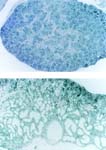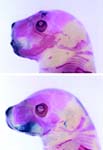Phenotypes associated with this allele
|
|
| Find Mice |
Using the International Mouse Strain Resource (IMSR)
Mouse lines carrying:
Gpc3tm1Fil mutation
(1 available);
any
Gpc3 mutation
(17 available)
|
|
|
mortality/aging
 |
• phenotype is stated to be similar to that of Gpc3tm1Fil male hemizygotes; however, no data are presented in J:73877
|
craniofacial
digestive/alimentary system
 |
• mutant females with an imperforate vagina display swelling of the perineum
|
reproductive system
 |
• mutant females with an imperforate vagina display swelling of the perineum
|
 |
• mutant females with an imperforate vagina have a dilated, fluid-filled uterus
|
 |
• mutant females exhibit an imperforate vagina at a higher frequency (30%) than wild-type females (4%)
|
immune system
renal/urinary system
respiratory system
skeleton
growth/size/body
Allelic
Composition |
Gpc3tm1Fil/Gpc3+
|
|
Genetic
Background |
B6.Cg-Gpc3tm1Fil |
|
| Find Mice |
Using the International Mouse Strain Resource (IMSR)
Mouse lines carrying:
Gpc3tm1Fil mutation
(1 available);
any
Gpc3 mutation
(17 available)
|
|
|

Cystic and dysplastic kidneys in Gpc3tm1Fil/Gpc3+ mice
renal/urinary system
 |
• from N4 on, some heterozygous females display cystic kidneys (also noted in a large proportion of mice from earlier backcrosses)
|
 |
• from N4 on, some heterozygous females display dysplastic kidneys (also noted in a large proportion of mice from earlier backcrosses)
• the degree of renal dysplasia varies from mouse to mouse
|
growth/size/body
 |
• heterozygotes display an intermediate size between hemizygous mutant males and wild-type controls at all time points
|
 |
• from N4 on, some heterozygous females display cystic kidneys (also noted in a large proportion of mice from earlier backcrosses)
|
Allelic
Composition |
Gpc3tm1Fil/Y
|
|
Genetic
Background |
B6.Cg-Gpc3tm1Fil |
|
| Find Mice |
Using the International Mouse Strain Resource (IMSR)
Mouse lines carrying:
Gpc3tm1Fil mutation
(1 available);
any
Gpc3 mutation
(17 available)
|
|
|

Some Gpc3tm1Fil/Y embryos exhibit mandibular hypoplasia
mortality/aging
 |
• by N8, all mutants die prior to weaning; all studies described are performed in mice obtained from backcrosses N7 to N9 with C57BL/6
|
 |
• Background Sensitivity: a proportion of mutants survive beyond the first day, esp. in earlier backcrosses (N2 to N4)
• after N4, only 10% of males that can be typed are hemizygous (many are cannibalized); only 2 out of 21 survive to weaning
|
craniofacial
 |
• 10% of mutants from N7 and N8 exhibit complete lack of mandible, with only myxomatous stroma and overlying haired skin in place of the rami of the mandible
|
growth/size/body
 |
• hemizygous males exhibit a significant developmental overgrowth relative to wild-type mice
• at birth, hemizygotes are 30% heavier than wild-type
|
 |
• at E16.5, two classes of epithelial cysts are identified in the medulla: cuboidal cell cysts and squamous cell cysts
(J:67732)
• from N4 on, all mutants display cystic kidneys (also noted in a large proportion of mice from earlier backcrosses)
(J:73877)
|
 |
• at E13.5, mutant kidneys are significantly larger than wild-type kidneys
|
 |
• at birth, mutant lungs weigh 28% more than wild-type lungs probably due to debris accumulation, as no disproportionate overgrowth is observed thereafter
|
homeostasis/metabolism
immune system
 |
• mutants from N2 to N4 that die before weaning exhibit pneumonia, with accumulation of cellular debris and mucus in small and medium size bronchioles
• as early as P0, the lumens of airways contain an admixture of stranding mucus and sloughed epithelial cells
• by P5, the entire surface of the respiratory epithelium is covered with mucus
|
 |
• mutants from N2 to N4 that die before weaning exhibit rhinitis
|
 |
• mutants develop respiratory infections with a higher frequency than wild-type mice
|
renal/urinary system
 |
• at E16.5, two classes of epithelial cysts are identified in the medulla: cuboidal cell cysts and squamous cell cysts
(J:67732)
• from N4 on, all mutants display cystic kidneys (also noted in a large proportion of mice from earlier backcrosses)
(J:73877)
|
 |
• at E13.5, mutant kidneys are significantly larger than wild-type kidneys
|
 |
• at E16.5, mutant cortical collecting duct (CCD) cells show a 3-fold increase in cell proliferation relative to wild-type CCD cells
|
 |
• by E16.5, cortical tissue elements (glomeruli and tubules) are present but appear disorganized
|
 |
• from N4 on, all mutants display dysplastic kidneys (also noted in a large proportion of mice from earlier backcrosses)
• the degree of renal dysplasia varies from mouse to mouse
|
 |
• at E16.5, mutants show a significant increase in apoptosis in medullary collecting duct (MCD) cells (16-fold) and in cuboidal cystic cells (1.6-fold)
(J:67732)
• notably, cell proliferation in medullary cysts - but not in MCD cells - is increased by 4.9-fold in cuboidal cell cysts and 3.2-fold in squamous cell cysts
(J:67732)
• by E15.5, the medulla of mutant kidneys begins to degenerate resulting in reduced whole kidney mass
(J:73877)
• by E16.5, the mutant medulla is relatively devoid of tubular structures; epithelial cysts are found in an irregular pattern
(J:73877)
• by E18.5, the medulla appears fully dysplastic: medullary tubules are reduced in number, disorganized, and often cystic
(J:73877)
|
 |
• at E13.5, mutant kidneys are disproportionally larger than wild-type kidneys
• notably, no significant weight differences are noted in kidney at E16.5, E18.5, and P0
|
 |
• mutants display overgrowth of the ureteric bud, but not the blastema-derived tissue elements, as early as day 1 after blastema induction
• this developmental anomaly of the ureteric bud/collecting system is due to increased proliferation of cells in this tissue element
• in contrast, no significant differences in mesenchymal cell proliferation are noted at E12.5, E13.5 or E16.5
|
 |
• starting at E12 and persisting through E16.5, mutant kidneys show enhanced branching of the ureteric bud, with a 3-fold increase of ureteric bud surface area in hemizygous kidneys
|
respiratory system
 |
• at birth, mutant lungs weigh 28% more than wild-type lungs probably due to debris accumulation, as no disproportionate overgrowth is observed thereafter
|
 |
• mutants from N2 to N4 that die before weaning exhibit pneumonia, with accumulation of cellular debris and mucus in small and medium size bronchioles
• as early as P0, the lumens of airways contain an admixture of stranding mucus and sloughed epithelial cells
• by P5, the entire surface of the respiratory epithelium is covered with mucus
|
 |
• mutants from N2 to N4 that die before weaning exhibit rhinitis
|
skeleton
 |
• 10% of mutants from N7 and N8 exhibit complete lack of mandible, with only myxomatous stroma and overlying haired skin in place of the rami of the mandible
|
Allelic
Composition |
Gpc3tm1Fil/?
|
|
Genetic
Background |
involves: 129 * C57BL/6 |
|
| Find Mice |
Using the International Mouse Strain Resource (IMSR)
Mouse lines carrying:
Gpc3tm1Fil mutation
(1 available);
any
Gpc3 mutation
(17 available)
|
|
|
hematopoietic system
|
|
• increased number of colony forming cells (CFCs)
|
|
|
• in the bone marrow due to reduced maintenance
• KLS cells in the peripheral blood
|
|
|
• reduced migration toward CXCL12 and bone marrow
• increased number of hematopoietic stem cells in the G2/M phase
• however, migration is not affected by TFPI and lineage commitement is normal
|










 Analysis Tools
Analysis Tools
